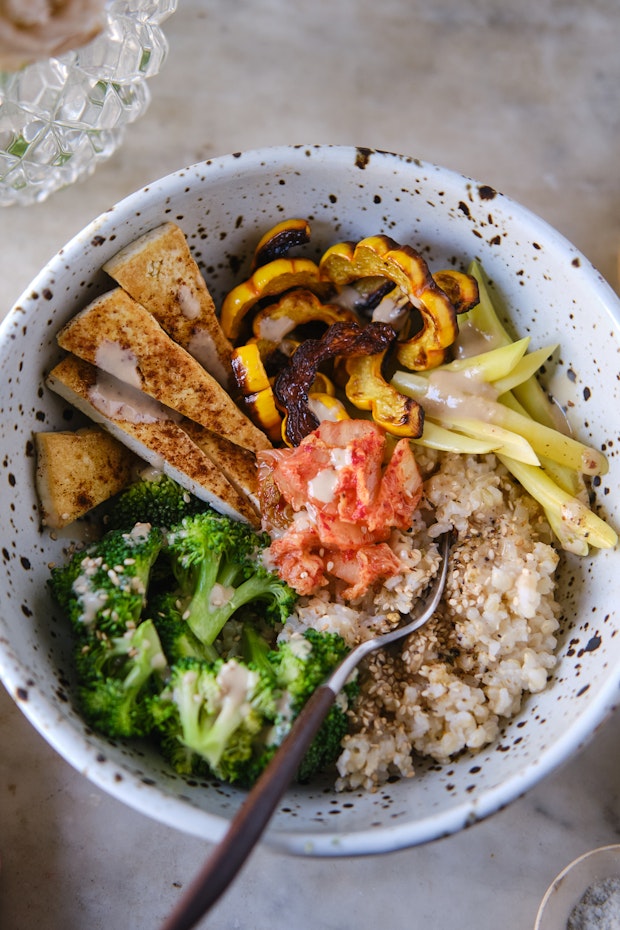Fall Comfort Food, German Style
Maybe it’s because I’ve been wearing my Operation Connect Goggles™ all the time lately, but when I flipped through Luisa Weiss’s new book Classic German Cooking last week, my first impulse was... The post Fall Comfort Food, German Style appeared first on Dinner: A Love Story.


Maybe it’s because I’ve been wearing my Operation Connect Goggles all the time lately, but when I flipped through Luisa Weiss’s new book Classic German Cooking last week, my first impulse was to invite someone over for dinner and serve them a pot of Linsensuppe Mit Pflaumen (Lentil Soup with Sausage and Prunes) or Wiener Servietteenknödel Mit Pilzgulasch (Bread Dumplings with Mushroom Goulash) or Käsespätzle (Swabian Noodles with Mountain Cheese and Caramelized Onions), then maybe spoon up some Bratäpfel Bit Vanillesobe (Almond-Stuffed Baked Apples with Vanilla Sauce) for dessert. Every photo, every recipe, seemed to shout “Make this for someone who needs to be taken care of…”
all the time lately, but when I flipped through Luisa Weiss’s new book Classic German Cooking last week, my first impulse was to invite someone over for dinner and serve them a pot of Linsensuppe Mit Pflaumen (Lentil Soup with Sausage and Prunes) or Wiener Servietteenknödel Mit Pilzgulasch (Bread Dumplings with Mushroom Goulash) or Käsespätzle (Swabian Noodles with Mountain Cheese and Caramelized Onions), then maybe spoon up some Bratäpfel Bit Vanillesobe (Almond-Stuffed Baked Apples with Vanilla Sauce) for dessert. Every photo, every recipe, seemed to shout “Make this for someone who needs to be taken care of…”
It turns out, when it comes to German food, my instinct was not that unusual. As Luisa writes in the introduction, “German food doesn’t hold the same romantic allure as Italian or French food…and yet, to so many, German food is the purest kind of comfort food. It is simple and hearty, the kind of cooking one turns to in the depths of winter to warm the very soul, the type of cooking that might not ever win a beauty award, but that will more than make up for it in terms of its power to nourish and comfort.”

Classic German Cooking is a collection of “the essential everyday recipes of Germany and Austria” and it is every bit as approachable and well-written as its 2016 companion, Luisa’s Classic German Baking. (Think Apfelkuchen and Pfeffernüsse; Sachertortes and Linzertortes! Am I killing you here?) It just so happens that Luisa, who lives in Berlin, was in town last night promoting the book and not that she needs anyone to mother her, but who better to invite over for one of those cozy dinners than the author herself, in the middle of a thousand-mile book tour?

Not that I needed much of an excuse to invite her over — anyone who reads her wonderful newsletter knows how much fun it is to hear what she’s cooking and reading — remember that time she shared every single book she read in 2022? I decided to make her Erbseneintopf, or Thick Pea Stew, with leeks, bacon, split peas, marjoram, and Wiener Würstchen, and end with the Almond-Stuffed Apples. When Luisa left she thanked me for making her childrens’ most requested dinner, which I count as a win.

Thick Pea Stew (Erbseneintoph)
From Classic German Cooking, by Luisa Weiss
Serves 4
From Luisa: This is my mother-in-law’s Erbsensuppe recipe, a classic German Eintopf if you ever saw one. It’s thick and satisfying; all you need with this is a crusty roll to clean the plate. While pea soups abound all over the world, in Germany they are usually associated with Berlin, historically a working-class city where thrifty but filling meals have always been essential. Aschinger’s, an institution at Berlin’s Zoo Station for decades, was famous for its cheap pea soup and free Brötchen.
Traditional Berlin pea soup used to be made with Eisbein (salted pork knuckle), but nowadays a bit of Schinkenspeck or even a thick slice of Kassler (cured, smoked pork loin, available at German butchers) will do (if you use Kassler, add it with the broth, then take it out at the end of cooking, shred it, and return it to the pot and mix well). In Germany, you use Suppengrün, that bundle of leek, carrots, and celery root sold at every grocery store, as the backbone of the soup. Marjoram is the classic herb to use; I think of it as the oregano of the north. It pairs beautifully with the rich porky flavor of the Schinkenspeck and the savory aromas of the Suppengrün.
If you happen to have some raw Sauerkraut on hand, try serving the pea soup with a forkful of it on top. The sour, crunchy cabbage is a great counterpoint to the creamy, hearty soup. Serve with crusty rolls.
3 Tbsp olive oil or vegetable oil
1 medium onion, finely chopped
1/3 cup / 50g minced Speck or lean bacon
1 leek, root and dark green part trimmed, chopped
1 medium carrot, peeled and diced
1-inch / 2.5cm thick slice of celery root, peeled and cut into small dice
2 tsp dried marjoram
1 tsp salt, plus more as needed
Freshly ground black pepper
1½ cups / 300g dried split green peas
5 to 6 cups / 1.1 to 1.4L vegetable or chicken broth
3 medium waxy potatoes, like Yukon Gold, peeled and diced
4 Wiener Würstchen or hot dogs, cut into bite-size rounds
Place the oil in a large pot over medium-high heat. Add the onion and Speck and cook, stirring occasionally, for about 5minutes. Add the leek and stir well. Cook for another 5 minutes. Add the carrot and celery root and stir well. Cook for another 5 minutes. Add the marjoram, salt, and pepper.
Pour in the peas and the broth. Stir well and bring to a boil. Lower the heat to a simmer, cover, and cook for 20 minutes.
Add the potatoes and stir well. Cook for another 20 minutes. The peas and potatoes should be soft and tender. Taste for seasoning and adjust if necessary.
4 When the soup is ready, take it off the heat and stir in the Würstchen. Let sit for a few minutes, until the Würstchen are warmed through, then serve.
P.S. Remember Luisa’s German Marble Cake?
The post Fall Comfort Food, German Style appeared first on Dinner: A Love Story.
What's Your Reaction?








































